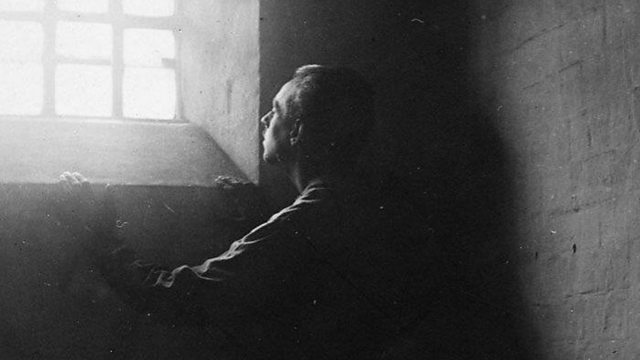
Caernarfon Prison, North Wales: Jailed for Refusing to Kill
There were approximately 16,500 Conscientious Objectors during World War One across Britain, and of those between 700 – 900 came from Wales.
There were between 700 – 900 Conscientious Objectors in Wales during World War One and in 1917 it was no soft option. It meant a tribunal, imprisonment, hard labour and poor rations. Often 'Conchies', as they were known, attracted considerable stigma among peers, and were humiliated and sneered at and sometimes called cowards and shirkers. Whilst in prison they were often not given sympathy either from the guards or from the authorities. In Wales for example five Objectors died in prisons or in detention as a result of the treatment they received.
People often think of Conscientious Objectors as pacifists, which is true in the case of many Christians who regarded the taking of life unacceptable. However, a greater number of people opposed the war on political and socialist grounds, thinking this was a capitalist war between imperialist powers that had nothing to do with the working classes. That argument was very persuasive at that time, especially in South Wales mining areas within the South Wales Miners Federation. Those men were increasingly influential in the Union to the point that in 1917 the South Wales Miners stopped Conscription from being adopted in the industry for 11 months until the end of the year.
Objectors who were absolutists, who didn’t want to compromise with the system, would go to a Court Martial who would imprison them for an initial 3-6 months. Many would then be imprisoned time after time - every time they were released from prison they would go back to the army, refuse to fight, and get Court Martialled again and imprisoned for a longer period. Emrys Hughes from Abercynon, was the most imprisoned Conscientious Objector in Wales. He became the son-in-law of Keir Hardy, the Scottish Labour politician for South Ayrshire. He failed to convince the tribunal that he was a conscientious objector, because in those days tribunals refused to accept objections from people who were opposing the war on political or social grounds. Caernarfon was amongst the prisons he was sent to.
There were other prisons in Wales used to house Conscientious Objectors such as Cardiff Prison. Objectors were often sent there for a couple of months before being moved elsewhere to spend a longer sentence in another prison or a work centre. Carmarthen Prison was also used to hold Objectors and about 30 Conscientious Objectors were there during the period of 1916-1919. The most eminent Conscientious Objector who stayed in Carmarthen Prison was Arthur Horner. He became a prominent miners leader and a key member of the South Wales Miners Federation and The National Union of Mine Workers.
In 1918, the authorities came after Horner because of his objection. He managed to escape to Ireland where he joined the Irish Citizens Army in Dublin under a pseudo name. When his wife had a baby, he returned to Wales but was arrested in Holly Head carrying seditious leaflets and Court Martialled. In Carmarthen Prison, Horner and a number of other Objectors went on a ‘cat-and-mouse hunger strike’. This was a hunger strike which was so serious that the authorities released the Objectors from prison, let them have something to eat and would then re-arrest them. Horner eventually successfully challenged the system and he and about a half a dozen Objectors were left alone.
The Conscientious Objectors in Wales very often came from areas where there was support for their cause. A high proportion were socialists and members of the Independent Labour Party. In areas of South Wales like Briton Ferry, Swansea Valley, Aberdare, Merthyr and the Rhymney Valley, there were strong groups of people who were ILP supporters and very much in favour of the actions of Conscientious Objectors. For example in one of the first tribunals in Pontardawe in March 1916 a total of sixty men all appeared at the same time. In Merthyr there were forty. This suggests strongly that this wasn’t an individualistic lonely act, but undertaken within a certain political context with an organisation attached. In terms of the dependants of imprisoned Objectors there was a support network with money being raised to help the families involved. This was done through bodies like the Independent Labour Party, and the Quakers.
The absolutists amongst the Conscientious Objectors were a minority. Most accepted some sort of alternative work such as volunteering for the Royal Army Medical Core which didn’t involve carrying arms, but did support the war effort. Others agreed to join the Home Office Scheme where work camps were set up to work on Civil Engineering projects. In Wales these work camps were located in places like Llannon outside Tumble and Hirwaun outside Aberdare.
Location: Caernarfon Prison, Gwynedd LL55 2AY
Image courtesy of The Imperial War Museum
Contributors: Aled Eurig - Opposition to the Great War in Wales, The late Dilys Lewis, Llanllechid, The late Rupert Rees, Aberdare - Filmed in 1993 for ����ý Wales 'All Our Lives'
Duration:
This clip is from
Featured in...
![]()
Conscientious Objectors—World War One At Home
The individuals who made a stand against conscription
![]()
Video & Footage
Clips from programmes, WW1 footage & slideshows
![]()
Protest—World War One At Home
Race riots, rent strikes and conscientious objectors' resistance
![]()
����ý Radio Wales—World War One At Home
Places in Wales that tell a story of World War One
More clips from World War One At Home
-
![]()
The loss of HMY Iolaire
Duration: 18:52
-
![]()
Scotland, Slamannan and the Argylls
Duration: 07:55
-
![]()
Scotland Museum of Edinburgh mourning dress
Duration: 06:17
-
![]()
Scotland Montrose 'GI Brides'
Duration: 06:41







